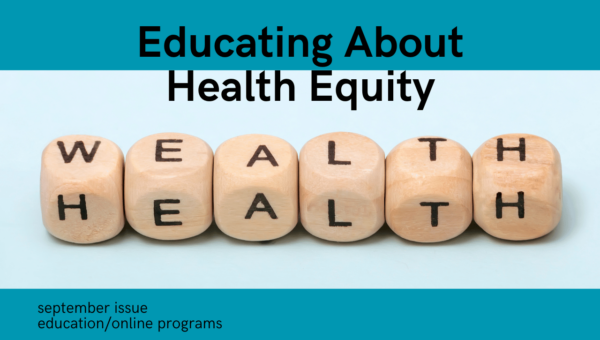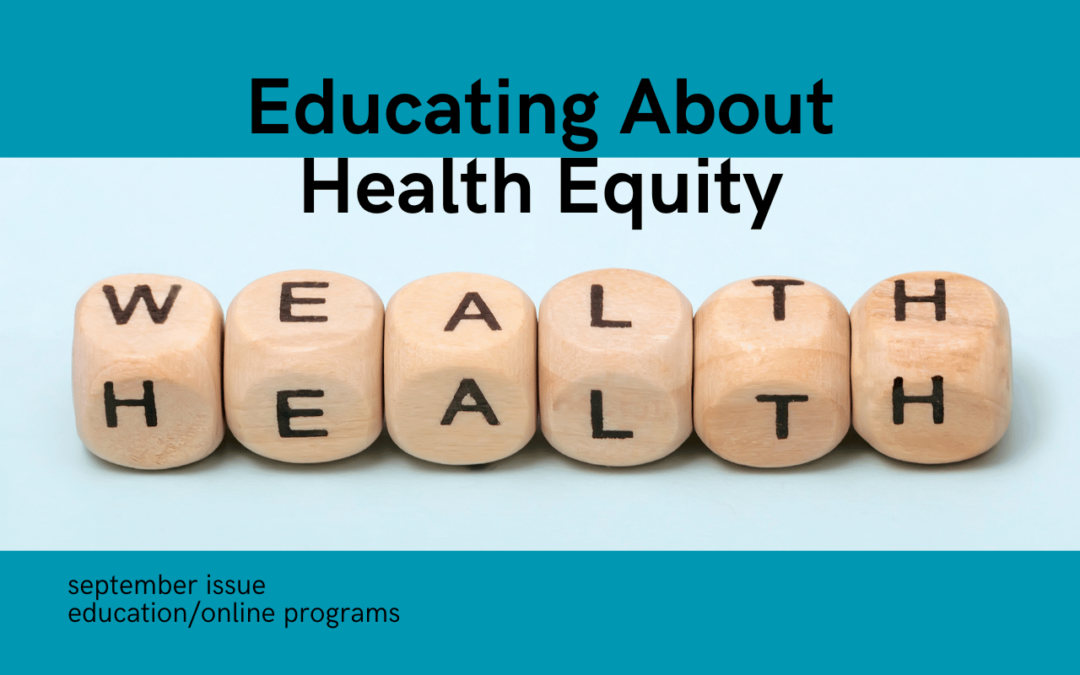Nursing has always held health equity as a critical value in many ways. Nurses strive to deliver the best care to all patients, independent of socioeconomic status, gender, race, or other factors.
Health equity arguably gets even more attention than in the past. And that attention also occurs in nursing schools, where nurses are presented with the concept of health equity.
In this article, we examine how various schools teach health equity. But first, let’s define the term.

“Fair and Just Opportunity”
Health equity, according to the Centers for Disease Control and Prevention (CDC), “is the state in which everyone has a fair and just opportunity to attain their highest level of health.” Educator Jessica Alicea-Planas, PhD, MPH, RN, of the Egan School of Nursing and Health Studies at Fairfield University in Fairfield, Connecticut, echoes that sentiment, defining health equity as “ensuring that everyone has an opportunity to live whatever they feel their healthiest life should be.”
“Equity should mean that people have the opportunity to get what they need when they need it,” notes Alicea-Planas, associate professor of nursing at Egan and practicing nurse at a community health center in Bridgeport, CT. “That’s something that has historically been lacking for certain communities within our healthcare system.”
Health equity means that “everyone has the ability and opportunity to be healthy and to access healthcare to help them maintain health,” says Latina Brooks, PhD, CNP, FAANP, associate professor at Frances Payne Bolton School of Nursing, Case Western Reserve University, Cleveland, Ohio. Brooks also directs the MSN and DNP programs at Frances Payne.
Beyond Accessibility
The CDC notes that achieving health equity requires ongoing efforts to address historical and contemporary injustices; overcome economic, social, and other obstacles to health and healthcare; and eliminate preventable health disparities.
Health equity isn’t just about access to healthcare, notes Elaine Foster, PhD, MSN, RN, vice president of nursing, Education Affiliates. It can also relate to whether a diabetic patient, for instance, knows what to get checked. “I think sometimes we’ve put a very narrow description on health equity, and I think if you were to flesh it out, it goes beyond that accessibility,” Foster notes.
“You can even take health equity that next step and say, Do you have an advocate or do you have someone who knows to push the envelope?” says Foster. “We have to be active participants in our healthcare these days to get what we need.”
Besides accessing resources, health equity involves “understanding how to navigate our healthcare system,” says Alicea-Planas. “It is understanding the information that’s being provided to us by healthcare providers and being able to use it for patients to do well on their health and wellness journey.”
Teaching Equity
At various schools, health equity is integrated throughout the course of study. For instance, at Adelphi University College of Nursing and Public Health, Long Island, New York, health equity is threaded throughout the undergraduate and graduate curriculum in various courses, notes Deborah Hunt, PhD, RN, Dr. Betty L. Forest dean and professor. For example, in the school’s community health course, there is a focus on vulnerable and underserved populations. In the childbearing course, Hunt notes, there is a focus on health disparities and maternal and infant mortality.
Foster notes that health equity is threaded into the curriculum at the 21 nursing schools within the Education Affiliates system. Likewise, at Frances Payne Bolton, health equity is integrated into courses. However, Brooks notes that some courses go more in-depth, such as discussing health equity in vulnerable populations.
At Egan, introductory courses talk a lot about health equity and social determinants of health, notes Alicea-Planas, as do clinical courses. “I think a big part of understanding health equity is also understanding social determinants of health,” says Alicea-Planas. “I am super excited that now in the nursing curriculum, we have lots of conversations around those social determinants of health and how they influence people’s ability to attain their highest level of health.”
The Takeaways
One crucial learning that Alicea-Planas hopes students take away is that for students who haven’t been exposed to many people from different backgrounds, it’s essential “to understand how historically our healthcare system has treated certain communities of color. That factors into people’s feelings about how doctors or nurses treat them, influencing their ability to seek care.”
Alicea-Planas notes that students wanting to explore the topic of implicit bias can take a test on the Project Implicit website. In addition, the Kirwan Institute for the Study of Race and Ethnicity at The Ohio State University offers online modules on implicit bias.
Foster hopes that students learn that no matter what the patient’s background, “Everyone is entitled to good, nonjudgmental care within the healthcare system.” Students must learn “not to impose our beliefs, our judgment on someone. Because until we get rid of that type of judgment, we will never overcome issues with health equity because we’ve got to first check our beliefs and opinions at the door and say I’m going to give the best care possible to these patients.”
Sign up now to get your free digital subscription to Minority Nurse.
- Meeting Mental Health Needs - April 25, 2024
- Nursing Informatics: Connecting Tech with Care - March 22, 2024
- Practical Strategies for Implementing Evidence-Based Practice - February 22, 2024



